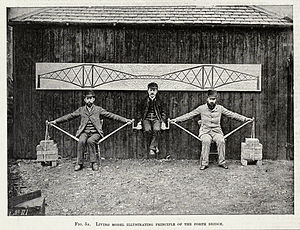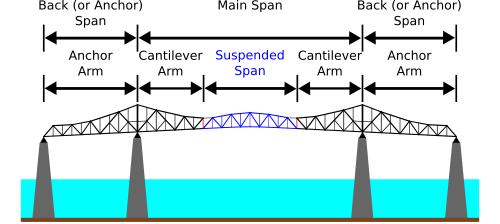Cantilever bridge - Simple English Wikipedia, the free encyclopedia
A cantilever bridge is a bridge built using a cantilever. A cantilever is only supported on one end. For small footbridges, the cantilevers may be simple beams. For large cantilever bridges, designed for road or rail traffic the cantilevers are trusses built from structural steel, or box girders built from prestressed concrete. The steel truss cantilever bridge was a major engineering breakthrough when it was first used, because it can span distances of over 1,500 feet (460 m). They can be more easily built at difficult crossings as they do not need to be supported during the construction.
Origins
[change | change source]Engineers in the nineteenth century knew that a bridge built across multiple supports would distribute the loads among them. This meant there would be lower stresses in the girder or truss and meant that longer spans could be built.[1] Several nineteenth century engineers designed continuous bridges with hinge points mid-span.[2] The use of a hinge in the multi-span system meant that engineers could better work out the loads and stresses on the bridge[3] It also meant the bridge could handle the foundations settling at different rates.[4]
Heinrich Gerber was one of the engineers to obtain a patent for a hinged girder (1866) and is recognized as the first to build one.[5] The Hassfurt Bridge over the Main river in Germany has a central span of 124 feet (38 meters). Completed in 1867, it was the first modern cantilever bridge.[6] Other early cantilever bridges included the High Bridge of Kentucky by C. Shaler Smith (1877), the Niagara Cantilever Bridge by Charles Conrad Schneider (1883) and the Poughkeepsie Bridge by John Francis O'Rourke and Pomeroy P. Dickinson (1889).[7] The Kentucky River Bridge spanned a gorge that was 275 feet (84 meters) deep. It was built with a cantilever which meant that it did not need to be supported during the building.[8] The most famous early cantilever bridge is the Forth Rail Bridge. This bridge held the record for longest span in the world for 17 years.

Benjamin Baker showed how the cantilever system worked in the photo on the left. The suspended span, where Kaichi Watanabe sits, is seen in the center. The need to resist compression of the lower chord is seen in the use of wooden poles while the tension of the upper chord is shown by the outstretched arms. The action of the outer foundations as anchors for the cantilever can be seen in the placement of the counterweights.[9]
Function
[change | change source]Cantilever Bridge.—A structure at least one portion of which acts as an anchorage for sustaining another portion which extends beyond the supporting pier.
— John Alexander Low Waddell, Bridge Engineering[10]
A simple cantilever span is formed by two cantilever arms extending from opposite sides of the obstacle to be crossed, meeting at the center. With a suspended span, the cantilever arms do not meet in the center; instead, they support a central truss bridge which rests on the ends of the cantilever arms. The suspended span may be built off-site and lifted into place, or constructed in place using special traveling supports.

With a balanced cantilever, the span is balanced by cantilevers going in the opposite direction. If these are anchored into solid foundations, they are called anchor arms. In a bridge built on two foundation piers, there are four cantilever arms: two which span the obstacle, and two anchor arms which extend away from the obstacle. Because of the need for more strength at the balanced cantilever's supports, the bridge superstructure often takes the form of towers above the foundation piers. The Commodore Barry Bridge is an example of this type of cantilever bridge.
Steel truss cantilevers support loads by tension of the upper members and compression of the lower ones. Commonly, the structure distributes the tension through the anchor arms to the outermost supports, while the compression is carried to the foundations beneath the central towers.
Prestressed concrete balanced cantilever bridges are often built using segmental construction.
Construction methods
[change | change source]Some steel arch bridges (such as the Navajo Bridge) are built using pure cantilever spans from each side. These are then joined with a pin, usually after forcing the meeting point apart. When the jacks are removed and the bridge decking is added the bridge becomes a truss arch bridge. Such unsupported construction is only possible if suitable rock is available to support the tension in the upper chord of the span during construction, usually limiting this method to the spanning of narrow canyons.
List by length
[change | change source]World's longest cantilever bridges (by longest span):[11]
- Quebec Bridge (Quebec, Canada) 1,800 feet (549 m)
- Forth Bridge (Firth of Forth, Scotland) 2 x 1,710 feet (521 m)
- Minato Bridge (Osaka, Japan) 1,673 feet (510 m)
- Commodore Barry Bridge (Chester, Pennsylvania, USA) 1,644 feet (501 m)
- Crescent City Connection (dual spans) (New Orleans, Louisiana, USA) 1,575 feet (480 m)
- Howrah Bridge (Kolkata, West Bengal, India) 1,500 feet (457 m)
- Veterans Memorial Bridge (Gramercy, Louisiana, USA) 1,460 feet (445 m)
- San Francisco – Oakland Bay Bridge (East Bay Span) (San Francisco, California, USA) 1,400 feet (427 m)
- Horace Wilkinson Bridge (Baton Rouge, Louisiana, USA) 1,235 feet (376 m)
- Tappan Zee Bridge (South Nyack, New York & Tarrytown, New York, USA) 1,212 feet (369 m)
Examples
[change | change source]- The Quebec Bridge is of the general structure demonstrated above.
- The Firth of Forth rail bridge with its three double cantilevers
- Eastern span of the San Francisco - Oakland Bay Bridge
- Original 1938 span of the Blue Water Bridge.
References
[change | change source]- ↑ DuBois, Augustus Jay (1902). The Mechanics of Engineering. New York: John Wiley & Sons. pp. 57, 190. Retrieved 2008-08-10.
- ↑ Bender, C. (1890). "Discussion on Cantilever Bridges by C.F. Findlay". Transactions of the Canadian Society of Civil Engineers. 3. Canadian Society of Civil Engineers.: 75, 79. Retrieved 2008-08-10.
- ↑ DeLony, Eric (1996). "Context for World Heritage Bridges". World Heritage Sites. International Council on Monuments and Sites. Archived from the original on 2012-01-09. Retrieved 2008-08-10.
- ↑ page 190
- ↑ page 79
- ↑ second paragraph of section on cantilevers
- ↑ [1] Archived 2012-01-09 at the Wayback Machine paragraphs 3 to 5 of cantilever section
- ↑ [2] Archived 2012-01-09 at the Wayback Machine paragraph 3 of cantilever section
- ↑ "paragraph 6 of cantilever section". Archived from the original on 2012-01-09. Retrieved 2012-03-19.
- ↑ Waddell, J.A.L. (1916). Bridge Engineering - Volume 2. New York: John Wiley & Sons, Inc. p. 1917. Retrieved 2008-08-19.
- ↑ Durkee, Jackson (1999-05-24). National Steel Bridge Alliance: World's Longest Bridge Spans (PDF). American Institute of Steel Construction, Inc. Archived from the original (PDF) on 2008-12-30. Retrieved 2007-11-03.
Other websites
[change | change source]- "Cantilever Bridge" by Sándor Kabai, The Wolfram Demonstrations Project, 2007.
- Bridges – Their Structure and Function Archived 2014-06-06 at the Wayback Machine, Brantacan
- Corporation, Bonnier (1919). Popular Science. Bonnier Corporation. p. 79.


 French
French Deutsch
Deutsch

